Written by Denise Doyen and illustrated by Barry Moser
This Blog breaks down and analyzes the components of one excellent picture book every month. Its one thing to read about the techniques that make a great story, but in order to really learn what those techniques are—its best to see them in action. If you want to be notified when a new analysis comes out, make sure and subscribe to this feature at the top of the page.
STORY/PLOT: Once Upon a Twice is a CAUTIONARY TALE. It’s a special kind of story that shows its reader how NOT to behave. A cautionary tale always contains a warning or an admonition against a particular behavior. But the character always engages in the behavior anyway, and always ends up facing potentially fatal consequences. In children’s stories, we don’t want anyone to die (THAT would be a marketing disaster), so the hero generally excapes by the skin of his teeth, or by luck, or by sheer wit. As you will see, all these things happen in a perfectly balanced execution; Once Upon a Twice is an ideally constructed cautionary tale.

into VOICE
Normally, I would continue with plot here, but if I didn’t take this detour, I would be cheating you out of the true brilliance of Once Upon a Twice. And that brilliance can be nailed down in one word: VOICE. But first I need to introduce an essential concept. ![]() A portmanteau is created by combining two words, both their sounds and their meanings, into one single (but more complex) word. A great example of a portmanteau is the word [ELECTROCUTION]. This is when you use electricity [ELECTRO] to perform an execution [CUTION]. Another example is the word [EMOTICON] which is an ICON that appears to express an EMOTion.
A portmanteau is created by combining two words, both their sounds and their meanings, into one single (but more complex) word. A great example of a portmanteau is the word [ELECTROCUTION]. This is when you use electricity [ELECTRO] to perform an execution [CUTION]. Another example is the word [EMOTICON] which is an ICON that appears to express an EMOTion.
The language in Once Upon a Twice is part of it’s magic. Notice that many of the words are portmanteaus, or simply made up words. This may seem at first glance like a bad idea. But think about how grown up language sounds to kids. They don’t know all the words we use, anyway. They evaluate new words for their context and gradually assess their meanings. So, if you were clever (and Doyen is extremely clever) you could make up words that merely SOUND LIKE the thing you are trying to convey and your reader will figure it out, because that’s what kids do. They’re experts at figuring out what words mean; it’s something they have to do every single day of their childhood to be successful, competent adults.
DEVELOPMENTAL: No matter what kind of story you write, if you intend to publish it, you need to make it developmentally relevant. What I mean by that is that it has to address some aspect of mental, social, or psychological growth. This is one of the most important features of Doyen’s story: it addresses and validates the way children assimilate language. And that’s huge. The box below shows a stanza from the text.
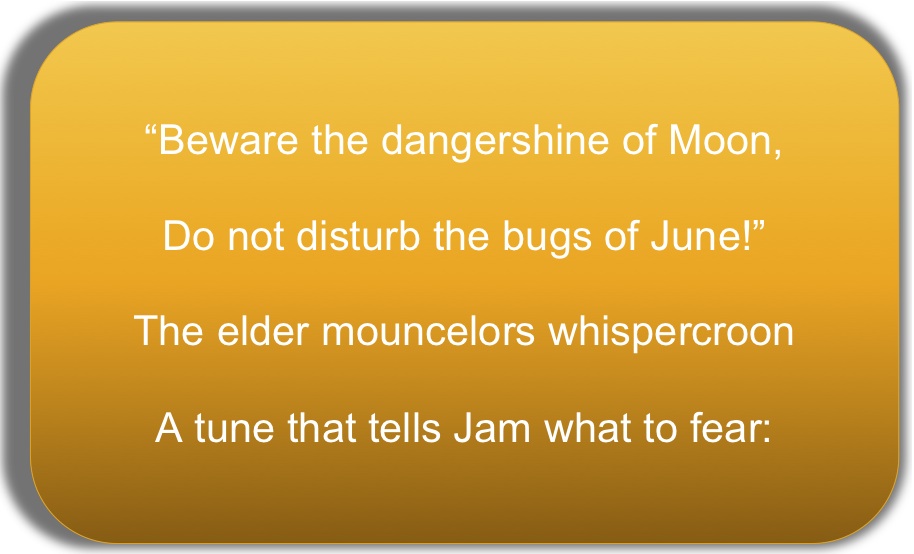
Dangershine: It isn’t a word, it’s a portmanteau that hints at the fact that the light (read SHINE) that comes from the moon is dangerous. Mice are nocturnal and so have good night vision. Most of their predators don’t. Any light makes them more visible in the dark and could be dangerous.
Mouncelors: It’s perfect. Mouse + counselors. Doesn’t get any better than that.
Whispercroon: Whisper + Croon. The biggest advantage of this one is that it rhymes with moon. Most of the time you can’t get away with this kind of word math–but you can if you just invented “mouncelors.”
Remember that voice is never measured by a single word or segment but by a style that must encompass the entirety of the story. There are no hard fast rules when it comes to voice. But a good rule of thumb is repetition. If you use some device repeatedly and consistently, you’ll likely find that your story voice is working. If you gain nothing else from this post, know that Doyen’s voice is the thing that sets this story apart. The story is good. The plot is solid. But it is Doyen’s voice and style that carry it to the top of its class. And that is why she won the E. B. White READ ALOUD Honor award.
Compare: Look at the last post, Corey Rosen Schwartz “The Three Ninja Pigs,” in which Corey uses phrases like: “Yo Bacon,” and “kick your butt.” They rock in that story, but neither would work in this story and “whispercroon” would fall flat as asphalt in “The Three Ninja Pigs.” Both Doyen and Rosen Schwartz have mastered first class voices, but they require a consistency of style to work.
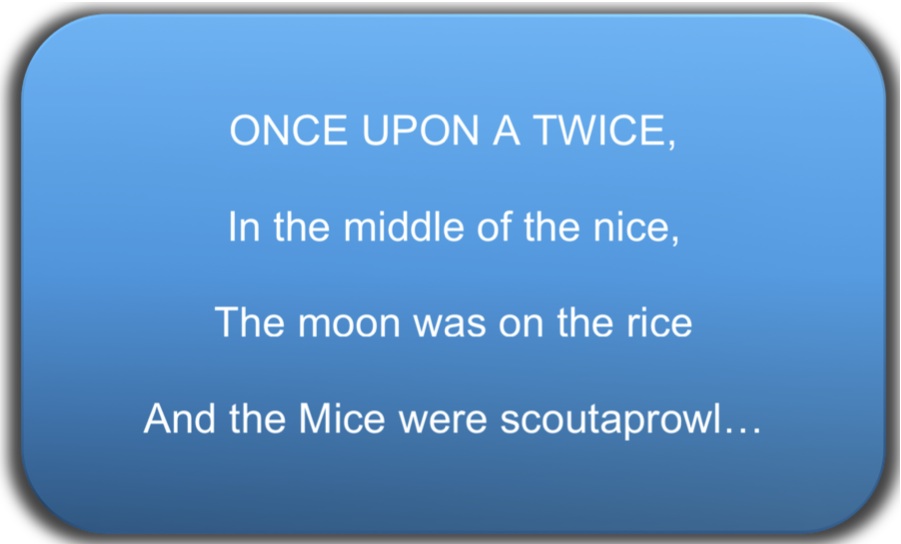
A note about MOOD: The passage above is the opening paragraph. Look at how it sets up the reader for the ambiance Doyen is creating. The first line is a marker; it’s a play on the most famous opener for children’s stories ever. And that line, Once Upon a Twice, sets you up for the altered logic of the entire piece. It works because everybody (even small children) KNOW the expression “once upon a time.” They know Doyen has altered it just slightly and the next line is okay, just because that alteration is so well done. When Doyen uses [NICE] as a noun, (when it is, in fact, an adjective), and when she says the moon was on the rice, it isn’t literal (although  Moser has brilliantly made it seem as if the moon really IS on the rice) the words are meant to evoke images. This is a poetic device that allows the author to set a mood. The final line brings it all together: “The Mice were scoutaprowl.” This last line is the one most important to the plot: Mice are scouting and prowling. The rest of the passage works to set the mood and introduce the voice.
Moser has brilliantly made it seem as if the moon really IS on the rice) the words are meant to evoke images. This is a poetic device that allows the author to set a mood. The final line brings it all together: “The Mice were scoutaprowl.” This last line is the one most important to the plot: Mice are scouting and prowling. The rest of the passage works to set the mood and introduce the voice.
Okay, so back to plot.
Set Up/Character: The main character is Jam. He gets this name because he stops to smell a rose and jams up the procession of mice toward some unknown destination. The destination doesn’t matter, what matters is he’s bucking the system. Doyen has set him up as both a rebel and a dreamer in one short introduction. Everybody likes a dreamer, and most of us like a rebel if he’s got a worthy cause.
Conflict: Doyen shows Jam briefly rejoining the mouse procession, but his rebel nature wins out: “I won’t scamper. I won’t scurry. A clever mousling need not worry.” Jam runs off into the “dangershine” for some “adventure.” What kid can begrudge him that? Also notice that the internal conflict (Jams rebel nature and thirst for adventure) and the external conflict (the danger lurking in the lettuce) are linked.
Rising Action: This is a cautionary tale, so Jam runs into some danger, the very danger he was warned about. As he prides himself on his independence, a snake lurks in the darkness waiting to pounce. The reader sees the danger long before Jam does and this creates an effective tension. Notice that in this book, the rising action is fairly short. Normally, that would result in a pacing issue. The rising action is generally the entire middle section of the book, but this book is less about tension than about sound. The poetry of this story trumps the tension. Don’t misunderstand– the tension is there and the rising action emerges from the conflict and escalates to a climax; all the required plot properties are included. The rising action is just a little bit smaller proportionally than is typical. And don’t forget the developmental aspect of the story’s design. Kids are listening to this book formulating a strategy for determining the meanings of unknown words by their contextual position. It’s huge. Again, that is why this book won an E. B. White award.
Climax: The snake attacks. It seems Jam is caught, but his quick reflexes save him. The reader sees Jam scared and huddled in a hole until morning. It might seem like this huddling in a hole should be the resolution, and in another story, it might be. But this is an exceptional story.
Resolution: The resolution is particularly clever because it validates Doyen’s title (in case you thought it was just clever without significance). In the end, the reader discovers that the story is being told by an old mouse. That mouse is Jam, fast forward from the time of the story’s occurrence, warning the young mouslings not to be foolish. One gets the impression the story has just been relived, that it has happened “Twice” (as in Once Upon a Twice).
Rhyme Scheme: AAAB CCCB
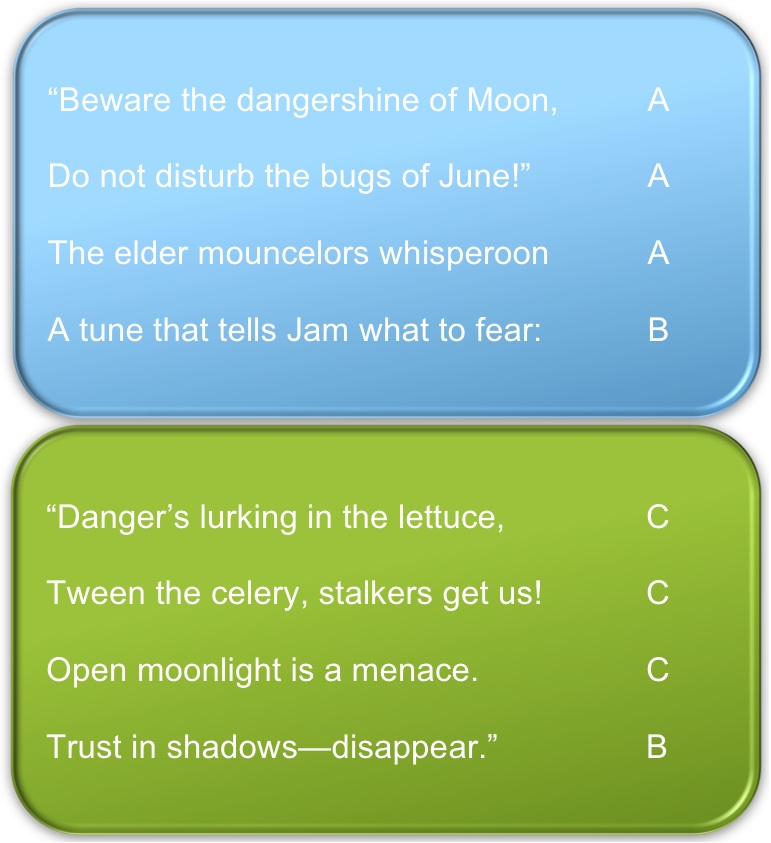
Notice that the rhyme scheme is pulled across two stanzas. That last line always rhymes with the last line in the subsequent stanza. This is a really clever design and I’ve used it as an example in the chapter on rhyme schemes.
BEAT COUNT: 4/4/4/4
A definition of Beat Count can be found in 202 Stanzas
METER: Iambic Tetrameter, Trochaic Tetrameter
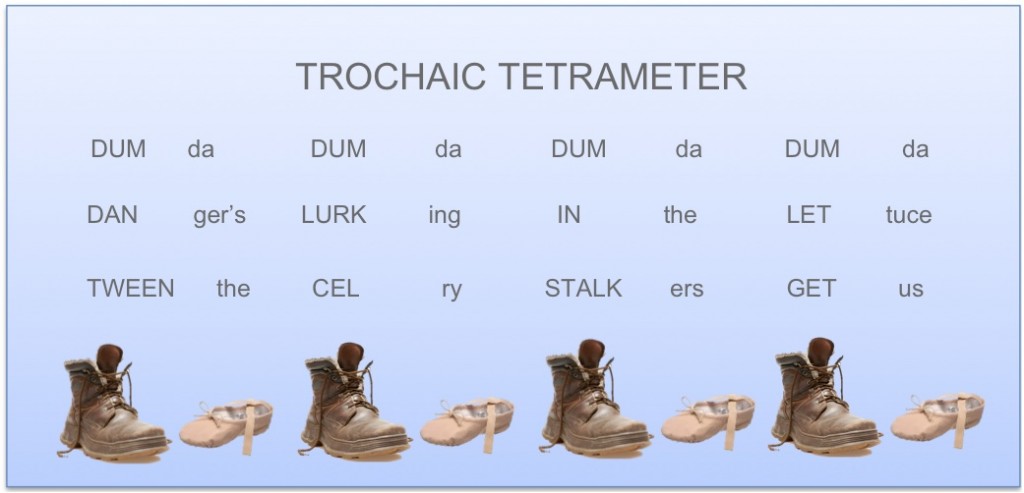
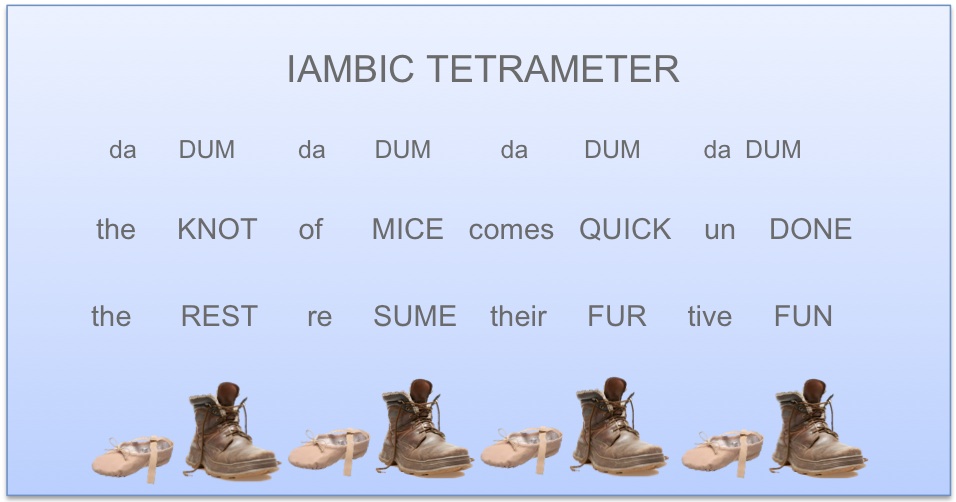
Notice that the only difference between the above meters is that the Iambic begins on a ballet slipper (UNstressed syllable) and the Trochaic begins on the Boot (STRESSED syllable). The order, pattern, and total number of syllables are all the same.
104 Important Meters and 105B Mixed Meter explain why Trochaic and Iambic Meters can be switched fairly seemlessly within a story.
Metrical Variances: Headless lines, Hypercatalectic lines, Catalectic lines
The box below shows a stanza with all of the above types of variance.
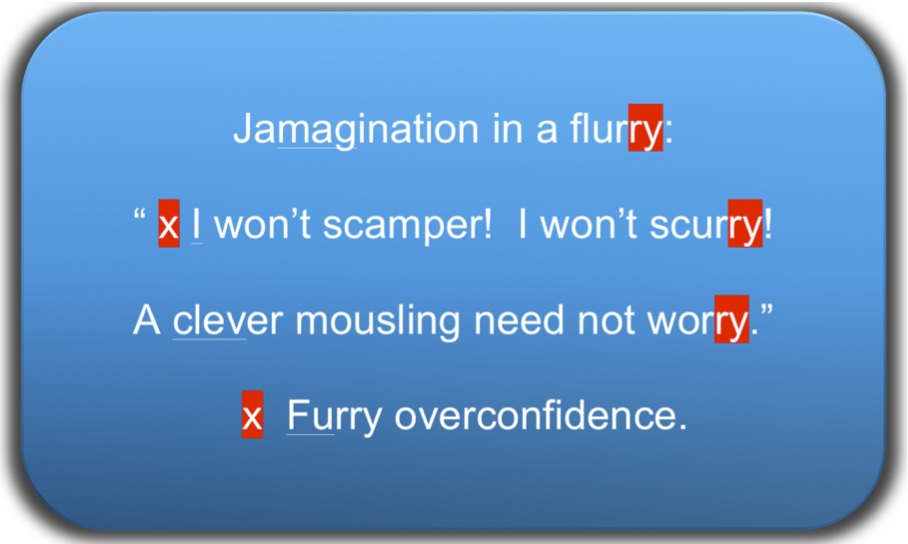
The key here is Base Meter. Deciding which of the highlighted syllables are catalectic or hypercatalectic would depend upon whether you consider the above stanza Trochaic or Iambic. If you look at the two square boxes above, you will see that the only things that distinguish one from the other are the initial and final syllables. This is a good lesson in why Base Meter is important. For more on this see 105B Mixed Meter
